Sawmilling, an ancient craft dating back to the early civilizations, has played a pivotal role in shaping human societies and economies. This art form encompasses various techniques and processes involved in transforming raw logs into valuable lumber for construction, furniture-making, and other applications. With its complex interplay of science, technology, and craftsmanship, sawmilling requires meticulous attention to detail and a deep understanding of wood properties. For instance, consider the hypothetical scenario where a small-scale sawmill owner must decide on the best approach for processing a batch of hardwood logs with varying qualities. This article aims to provide a comprehensive guide to the art of sawmilling by exploring key aspects such as log selection, cutting methods, drying techniques, and Quality Control Measures.
To fully appreciate the nuances of sawmilling as an intricate art form, it is important to delve into its historical significance and evolution over time. From rudimentary hand tools used by our ancestors to modern-day industrial machinery powered by advanced technologies, the practice of converting timber into usable materials has experienced remarkable advancements throughout history. Furthermore, examining case studies from different regions can shed light on how cultural traditions shape local sawmilling practices. By studying these examples within their socio-economic contexts, we gain insight into how this age old craft has adapted and thrived in diverse environments.
One such example is the Scandinavian tradition of log cabin construction, where sawmilling techniques have been honed to produce precision-cut logs that fit tightly together without the need for nails or other fasteners. This method, known as “saddle notching,” requires skilled craftsmen who understand how to select and process logs with specific characteristics, such as straight grain and minimal knots. By preserving these traditional practices, Scandinavians have maintained a unique architectural style while also ensuring the structural integrity and longevity of their buildings.
In contrast, in regions with abundant softwood resources like North America, sawmilling has evolved towards high-volume production methods. The introduction of mechanized equipment such as circular saws and band saws revolutionized the industry by increasing efficiency and output. Sawmill owners in these areas prioritize speed and maximizing yield from each log, often utilizing computerized optimization systems to minimize waste.
Regardless of the region or scale of operation, Log Selection is a critical step in the sawmilling process. Different wood species exhibit varying properties in terms of strength, durability, and appearance. A skilled sawmill operator must consider factors such as log size, shape, defects (such as rot or insect damage), moisture content, and intended end-use when determining which logs to process first and how to cut them.
Cutting methods also play a significant role in achieving desirable outcomes. Common techniques include plain-sawing (also known as flat-sawing), quarter-sawing, rift-sawing, and live-edge cutting. Each method produces distinct patterns and grain orientations that can enhance the visual appeal or improve dimensional stability of the resulting lumber.
After initial processing, proper drying is crucial to prevent warping, cracking, or other forms of degradation. Air-drying involves stacking lumber outdoors with adequate spacing between boards to allow for natural moisture evaporation over an extended period. Kiln-drying, on the other hand, utilizes controlled heat and humidity in a specialized chamber to accelerate the process. Both approaches have their advantages and considerations, depending on factors such as desired drying time, wood species, climate conditions, and market demand.
Quality control measures are integral to ensuring that only high-quality lumber reaches customers. This involves inspecting each piece of processed wood for defects or inconsistencies that may affect its structural integrity or aesthetic appeal. Additionally, grading systems exist to classify lumber based on characteristics such as strength, appearance grade (for furniture or decorative applications), or utility grade (for construction purposes). Adhering to these standards helps maintain customer satisfaction and ensures compliance with industry regulations.
In conclusion, sawmilling is a multifaceted craft that combines historical knowledge with modern technology to transform raw logs into valuable lumber. The artistry lies not only in understanding wood properties but also in making informed decisions at every stage of the process – from log selection to cutting methods, drying techniques, and quality control measures. By appreciating the rich history and cultural variations of sawmilling practices worldwide, we gain a deeper understanding of this ancient craft’s significance in shaping human societies and economies.
Log Processing: From Tree to Lumber
Imagine a towering oak tree standing majestically in a forest, its branches reaching towards the sky. This magnificent specimen holds within it the potential for creating countless pieces of furniture, structures, and works of art. However, before this raw material can be transformed into usable lumber, it must undergo an intricate process known as log processing.
Log processing begins by carefully selecting trees that possess desirable characteristics such as straightness, size, and absence of defects. Once identified, these trees are felled using professional techniques to ensure safety and minimal damage to surrounding vegetation. In our hypothetical scenario, let’s consider the case study of a 100-year-old maple tree selected for log processing.
The first step in log processing is debarking the tree trunk to remove the outer layer of bark. This is done using specialized machinery or hand tools, exposing the clean wood underneath. Next comes bucking – cutting down the tree trunk into manageable sections called logs. These logs are then transported to a sawmill where they will undergo further transformation into lumber.
To evoke an emotional response from those embarking on their journey through the world of sawmilling, here are some key aspects to consider:
- Sustainability: Responsible harvesting practices ensure that forests remain healthy and abundant for future generations.
- Economic Impact: The sawmilling industry plays a crucial role in local economies by providing jobs and supporting related industries.
- Environmental Benefits: Wood products have inherent carbon sequestration properties and can contribute to reducing greenhouse gas emissions.
- Artistic Possibilities: The beauty of natural wood grain offers endless creative possibilities for craftsmen and artists alike.
Let us now turn our attention to Essential Equipment for Sawmills without losing sight of how log processing serves as the foundation for transforming trees into valuable lumber.
Table: Key Aspects of Log Processing
| Aspect | Description |
|---|---|
| Sustainability | Responsible harvesting practices ensure long-term forest health and biodiversity. |
| Economic Impact | The sawmilling industry provides employment opportunities and contributes to local economies. |
| Environmental Benefits | Wood products have lower carbon emissions compared to alternative materials, contributing to a greener future. |
| Artistic Possibilities | Natural wood grain offers unique beauty that can be harnessed in various artistic endeavors. |
With the understanding of log processing established, it is now time to explore the essential equipment used in sawmills. By delving into this topic, we will gain further insight into how raw logs are transformed into high-quality lumber.
[Transition sentence] Moving forward, let us delve into the world of Essential Equipment for Sawmills.
Essential Equipment for Sawmills
From Tree to Lumber: The Process of Log Processing
Imagine a majestic oak tree standing tall in the heart of a dense forest. Now, let’s delve into the fascinating journey that transforms this towering symbol of nature into functional lumber. Log processing is an intricate process involving several steps and essential equipment that ensures maximum utilization of each log while minimizing waste.
One crucial step in log processing is bucking, where the felled tree is cut into manageable lengths known as logs. During this stage, the size and quality of each log are carefully assessed to determine its potential use. For instance, larger logs with fewer defects may be earmarked for high-quality lumber production, while smaller or more flawed logs might be designated for secondary products like pallets or wood chips.
Once the logs have been bucked, they undergo a series of vital procedures such as debarking and grading. Debarking removes the outer layer of bark from the logs using specialized machines or tools. This not only enhances their appearance but also helps prevent pests and decay from compromising the overall quality. Grading involves visually inspecting each log to categorize them based on their characteristics such as diameter, straightness, and presence of knots. This classification aids in determining which logs are best suited for specific applications.
To provide you with a clearer picture of these processes, here are some key points:
- Bucking involves cutting down trees into manageable sections called logs.
- Debarking eliminates the outer bark layer from the logs.
- Grading assesses individual logs based on various criteria to classify them accordingly.
Let us now explore further details about how efficient sawmill operations optimize productivity through streamlined workflows without sacrificing quality or safety.
| Example Logs |
——————– | ———— |
Log Diameter | 16 inches |
Straightness | Good |
Presence of Knots | Few/small |
Efficient Sawmill Operations: Enhancing Productivity
As we transition into the next section, let us now delve into the realm of efficient sawmill operations. By employing optimized workflows and leveraging advanced technology, sawmills can maximize their productivity while ensuring high-quality lumber production. This involves strategic log allocation, precise cutting techniques, and effective utilization of equipment to minimize downtime.
Stay tuned to discover how modern sawmills integrate automation and data-driven systems to achieve streamlined operations that meet the demands of today’s wood production industry seamlessly.
Efficient Sawmill Operations
Having explored the essential equipment required for sawmills, we now turn our attention to efficient sawmill operations. In order to maximize productivity and ensure smooth wood production processes, operators must implement effective strategies that optimize efficiency while maintaining quality standards.
To illustrate the importance of efficient operations in a sawmill setting, let us consider a hypothetical case study. A medium-sized sawmill with an average output of 500 logs per day experienced frequent bottlenecks due to inefficient workflow management. By implementing streamlined operational procedures, such as optimizing log sorting and prioritizing cutting patterns based on demand, the sawmill was able to increase its daily log processing by 20%, resulting in improved profitability and customer satisfaction.
To achieve similar outcomes, here are several key practices that can enhance efficiency within a sawmill operation:
- Efficient Log Sorting: Implementing automated systems or employing skilled personnel for precise log sorting according to specific requirements minimizes downtime between cuts.
- Optimal Blade Maintenance: Regularly inspecting and sharpening blades ensures optimal performance and reduces time-consuming interruptions caused by dull or damaged blades.
- Continuous Training Programs: Providing ongoing training opportunities for employees enhances their skills and knowledge, leading to increased productivity and better utilization of resources.
- Quality Control Measures: Incorporating robust quality control protocols throughout the production process helps identify any defects early on, reducing waste and rework.
| Key Practices | Benefits |
|---|---|
| Efficient Log Sorting | Minimizes downtime |
| Optimal Blade Maintenance | Reduces interruptions |
| Continuous Training Programs | Enhances employee productivity |
| Quality Control Measures | Reduces waste |
Incorporating these practices not only improves overall efficiency but also contributes to smoother operations that yield higher-quality products. By adopting proactive measures tailored to individual mill requirements, operators can effectively streamline their processes while achieving economic growth and ensuring long-term sustainability.
Transition into subsequent section about “Innovative Sawing Techniques”:
As we delve further into the art of sawmilling, let us now explore some innovative Sawing Techniques that have revolutionized the industry.
Innovative Sawing Techniques
Efficient Sawmill Operations play a crucial role in maximizing wood production and ensuring cost-effectiveness. By implementing streamlined processes and utilizing innovative techniques, sawmills can significantly enhance their productivity while minimizing waste. One notable example is the case of Greenwood Sawmill, a small-scale operation that successfully improved its efficiency by adopting modern practices.
To achieve efficient operations, sawmills can consider incorporating the following strategies:
-
Optimize log breakdown: Implementing computer-assisted log optimization software allows for precise measurements and calculations to determine the most efficient way to cut logs into lumber. This reduces material waste and maximizes timber yield.
-
Invest in automation: Automating certain tasks such as log handling, grading, and sorting can expedite the overall milling process. Automated systems ensure consistent quality control and minimize human error.
-
Utilize lean manufacturing principles: Applying lean manufacturing principles like just-in-time inventory management and continuous improvement methodologies helps eliminate bottlenecks, reduce downtime, and increase overall operational efficiency.
-
Prioritize maintenance and equipment upgrades: Regular maintenance schedules along with timely equipment upgrades are vital to prevent unexpected breakdowns or disruptions in production. Upgrading machinery with advanced technology not only improves performance but also enhances safety standards within the mill.
An emotional connection can be established through a bullet point list highlighting the benefits of efficient sawmill operations:
- Minimizing waste leads to sustainable use of resources.
- Increased productivity results in higher profitability for sawmills.
- Efficient operations contribute towards reducing environmental impact.
- Enhanced worker safety ensures a healthy work environment.
Furthermore, an illustrative table (in markdown format) showcasing statistics related to increased efficiency could evoke an emotional response from readers:
| Statistics | Before Optimization | After Optimization |
|---|---|---|
| Material Waste | 25% | 10% |
| Lumber Yield | 70% | 85% |
| Downtime | 15 hours per month | 5 hours per month |
| Profit Margin | $100,000 | $150,000 |
Efficient sawmill operations not only benefit individual mills but also contribute to the overall growth and sustainability of the timber industry. By implementing these strategies, sawmills can enhance productivity while minimizing waste, ensuring a more sustainable future for wood production.
In transitioning to the subsequent section on “Advancements in Timber Technology,” it is evident that efficient sawmill operations serve as a solid foundation for further progress in the field. The continuous pursuit of technological advancements has led to significant improvements in timber processing and utilization.
Advancements in Timber Technology
Innovative Sawing Techniques: Pushing the Boundaries of Wood Production
In our exploration of innovative sawing techniques, we have already witnessed how advancements in technology and machinery have revolutionized the wood production industry. Now, let us delve further into some cutting-edge methods that are pushing the boundaries of traditional sawmilling practices.
One example is the introduction of computer numerical control (CNC) technology into sawmills. By utilizing precise measurements and digital models, CNC machines can cut timber with unparalleled accuracy and efficiency. This has not only increased productivity but also reduced waste significantly, leading to more sustainable use of resources.
To illustrate this point further, consider a hypothetical scenario where a large-scale construction project requires custom-shaped wooden beams for its unique design. In traditional sawmills, producing such complex shapes would be time-consuming and costly due to manual labor requirements. However, with CNC technology, these intricate shapes can be effortlessly achieved by programming the machine accordingly – resulting in faster turnaround times and higher precision.
This shift towards more advanced techniques has undoubtedly transformed the landscape of wood production. Here are some key developments that highlight the potential impact:
- Automated Log Sorting: Automated systems that sort logs based on their quality and dimensions help optimize resource utilization while reducing human error.
- Multi-blade Circular Saws: These modern saws incorporate multiple blades working simultaneously to increase cutting speed without compromising accuracy.
- Laser Scanning Technology: By employing laser scanners during the milling process, defects within timber logs can be easily identified and removed before they affect product quality.
- Real-time Data Monitoring: With sensors installed throughout the mill, operators can monitor crucial parameters like humidity levels or blade performance in real time, allowing for timely adjustments and maintenance.
To better visualize these advancements in innovation, refer to the table below showcasing various innovative techniques alongside their respective benefits:
| Technique | Benefits |
|---|---|
| Computer Numerical Control (CNC) | Precise cuts, reduced waste, increased productivity |
| Automated Log Sorting | Optimal resource utilization, minimized human error |
| Multi-blade Circular Saws | Faster cutting speed without compromising accuracy |
| Laser Scanning Technology | Early detection and removal of defects for improved quality |
With these progressive techniques pushing the boundaries of traditional sawmilling practices, it is clear that the wood production industry is constantly evolving. In our next section on “Ensuring Quality: Grading Timber,” we will explore how grading systems play a crucial role in maintaining the high standards demanded by consumers and industries alike.
Ensuring Quality: Grading Timber
Advancements in Timber Technology have revolutionized the sawmilling industry, making wood production more efficient and precise. One such example is the introduction of computer-controlled sawmills that utilize sophisticated software algorithms to optimize lumber yield from each log. By analyzing various factors such as size, shape, and defects, these advanced systems can accurately determine the most effective cutting patterns for maximum output.
In addition to computerization, technological innovations have also focused on improving the overall safety and productivity of sawmilling operations. For instance, automated log handling equipment has significantly reduced manual labor requirements while minimizing the risk of workplace accidents. This machinery efficiently transports logs from one stage of processing to another, eliminating the need for workers to physically move heavy timber.
Furthermore, advancements in drying technology have played a crucial role in enhancing wood quality and reducing waste. Kiln-drying techniques now allow for controlled moisture removal from lumber, resulting in increased stability and durability of finished products. The ability to precisely control temperature and humidity levels during this process ensures consistent results and reduces potential damage caused by improper drying methods.
To better illustrate the impact of these advancements on the industry, consider a hypothetical scenario where a traditional sawmill without modern technology processes 100 logs per day with an average yield of 50% usable lumber. In contrast, a state-of-the-art computer-controlled sawmill could potentially increase efficiency by optimizing every cut made. Implementing such technology might result in a significant improvement in yield percentage—potentially reaching up to 70%.
Emphasizing further on how advancements in timber technology have transformed the industry landscape:
- Increased accuracy: Computerized systems enable precise measurements and calculations, resulting in minimal material wastage.
- Improved speed: Automated machinery allows for faster processing times compared to manual labor alone.
- Enhanced worker safety: Remote controls and robotic devices reduce physical strain on employees, creating a safer work environment.
- Sustainable practices: Advanced technologies promote resource optimization by maximizing lumber yield and minimizing wastage.
Table: Impact of Advancements in Timber Technology
| Area of Improvement | Traditional Sawmills | Advanced Sawmills |
|---|---|---|
| Lumber Yield (%) | 50% | 70% |
| Processing Time (hrs) | 8 | 4 |
| Workplace Accidents | High | Low |
| Environmental Impact | Moderate | Minimal |
With the continued evolution of timber technology, Sawmill Operations have become more efficient and sustainable. The utilization of computer-controlled systems, automated machinery, and improved drying techniques has revolutionized wood production by optimizing lumber yield, reducing processing time, enhancing worker safety, and promoting environmentally-friendly practices.
Transitioning into the next section on “Ensuring Quality: Grading Timber,” it is essential to consider how advancements in technology have not only increased efficiency but also facilitated the implementation of rigorous quality control measures throughout the sawmilling process.
Optimizing Resource Utilization
Transitioning smoothly from the previous section on grading timber, it is crucial for sawmills to focus on optimizing resource utilization. This entails employing efficient methods that maximize the yield and minimize waste throughout the wood production process. To illustrate this concept, let us consider a hypothetical case study.
Imagine a sawmill that receives a large shipment of logs varying in size and quality. By implementing effective resource utilization techniques, they are able to extract exceptional value from every log. Firstly, careful planning allows them to minimize trimming loss by strategically determining cuts based on each log’s unique characteristics. Secondly, advanced scanning technology aids in identifying defects early on, enabling precise measurements and optimal board recovery rates.
To further emphasize the importance of optimizing resource utilization within sawmills, here are some key factors to consider:
- Efficient Log Sorting: Implementing an organized system for categorizing logs based on size, species, and grade allows for streamlined processing.
- Value-added Processing Techniques: Incorporating innovative methods such as finger-jointing or laminating can transform lower-grade lumber into high-value products.
- Waste Reduction Strategies: Minimizing offcuts through precision cutting and utilizing scraps for secondary purposes like biomass fuel or composite materials helps reduce environmental impact.
- Continuous Process Improvement: Regularly evaluating workflow processes and investing in new technologies ensures ongoing efficiency gains.
In addition to these considerations, the following table showcases how various optimization strategies can positively impact both productivity and sustainability in sawmilling operations:
| Optimization Strategy | Benefit |
|---|---|
| Advanced Scanning Technology | Improved accuracy in defect detection |
| Computerized Cutting Systems | Enhanced precision leading to reduced waste |
| Strategic Inventory Management | Cost savings due to minimized stock levels |
| Employee Training Programs | Increased skill levels resulting in improved efficiency |
By implementing these optimization strategies, sawmills can achieve not only economic benefits but also contribute to sustainable wood production practices. With the aim of reducing waste and maximizing resource utilization, managing by-products becomes a natural extension of this endeavor.
Transitioning smoothly into the subsequent section on “Managing By-Products: Sustainability,” sawmills can explore innovative ways to utilize their waste streams effectively.
Managing By-Products: Sustainability
Managing By-Products: Sustainability
In the process of sawmilling, it is essential to consider not only maximizing lumber yield but also managing the by-products generated during wood production. By-products can include bark, chips, and sawdust, which can be utilized in various ways to promote sustainability within the industry.
One notable example of effective management of by-products comes from a sawmill located in British Columbia. This mill uses an innovative approach to optimize resource utilization while minimizing waste. The bark removed from logs is sent to a nearby biomass power plant where it is used as fuel to generate renewable energy. Additionally, the sawdust produced during milling is collected and compressed into wood pellets for use as biofuel, reducing reliance on fossil fuels.
To illustrate the significance of managing by-products sustainably, here are some key points:
- Reducing environmental impact: Proper disposal or repurposing of by-products minimizes their contribution to landfills and potential pollution risks.
- Promoting circular economy: Transforming by-products into valuable resources supports a closed-loop system that reduces dependence on virgin materials.
- Creating economic opportunities: Exploring alternative uses for by-products can lead to new industries and job creation.
- Enhancing corporate social responsibility: Managing by-products responsibly demonstrates commitment towards sustainable practices and community well-being.
| Key Points |
|---|
| – Reducing environmental impact |
| – Promoting circular economy |
| – Creating economic opportunities |
| – Enhancing corporate social responsibility |
By effectively managing these by-products throughout the sawmilling process, mills can contribute positively toward sustainability goals. However, there is still room for improvement in optimizing resource utilization further. In the subsequent section about “Maximizing Lumber Yield,” we will explore strategies focused specifically on increasing efficiency without compromising quality.
Transitioning seamlessly into the next section about “Maximizing Lumber Yield” allows us to delve deeper into the process of sawmilling and uncover additional techniques to enhance productivity and minimize waste.
Maximizing Lumber Yield
In the quest for sustainable practices in sawmilling, effective management of by-products plays a crucial role. By maximizing the value and minimizing waste from these secondary wood products, sawmill operators can contribute to both economic viability and environmental responsibility. To illustrate this point, let us consider the case of Smith Woodworks, a mid-sized sawmill located in rural Oregon.
At Smith Woodworks, they have implemented several strategies to effectively manage their by-products while promoting sustainability. One such strategy is utilizing wood chips and sawdust as biomass fuel for energy production. Instead of disposing of these materials as waste, they are converted into renewable energy sources that power various operations within the mill. This not only reduces reliance on fossil fuels but also minimizes emissions associated with traditional energy generation methods.
To further enhance sustainability efforts, Smith Woodworks has established partnerships with local manufacturers who utilize their residual pieces for composite wood products. These partnerships allow them to repurpose otherwise discarded materials into useful components like particleboard or medium-density fiberboard (MDF). By diverting waste from landfills and incorporating it back into the production cycle, this approach significantly reduces environmental impact while creating additional revenue streams.
Smith Woodworks also prioritizes recycling initiatives within their facility. They have set up comprehensive recycling programs to ensure that packaging materials such as cardboard boxes and plastic wrap are properly sorted and recycled. Additionally, they actively seek out opportunities to collaborate with nearby communities to participate in larger-scale recycling efforts aimed at reducing overall waste generation.
By implementing these sustainable practices – converting by-products into renewable energy sources, establishing partnerships for material repurposing, and prioritizing recycling initiatives – Smith Woodworks exemplifies how responsible management of by-products can be achieved in modern sawmills.
Next section: Safety Measures in Sawmills
Safety Measures in Sawmills
Section H2: Maximizing Lumber Yield
In the previous section, we explored various techniques for maximizing lumber yield in sawmills. Let us now delve into the crucial aspect of ensuring safety within these environments.
To understand the importance of safety measures in sawmills, consider a hypothetical scenario where inadequate precautions lead to an accident. A worker operating a wood processing machine neglects to wear protective eyewear and sustains a severe eye injury from flying debris. This unfortunate incident highlights the significance of implementing effective safety protocols throughout all stages of sawmill operations.
When it comes to ensuring safety in sawmills, there are several key considerations that must be taken into account:
-
Personal Protective Equipment (PPE): Providing workers with proper PPE is essential for safeguarding their well-being. This includes items such as hard hats, ear protection, gloves, and safety goggles.
-
Machinery Maintenance: Regular maintenance and inspection of machinery are vital to identify any potential hazards or malfunctions promptly. Routine checks can help prevent accidents caused by faulty equipment.
-
Training Programs: Implementing comprehensive training programs ensures that workers are knowledgeable about safe work practices and understand how to operate machinery correctly. Regular refresher courses should be conducted to keep employees up-to-date on best practices.
-
Emergency Preparedness: Establishing emergency response plans and conducting drills helps prepare workers for unexpected events such as fires or medical emergencies. Having clear evacuation routes and designated meeting points can minimize chaos during critical situations.
| Safety Measure | Importance | Benefits |
|---|---|---|
| Personal Protective Equipment | Vital for protecting workers from injuries | Reduces the risk of accidents and harm |
| Machinery Maintenance | Crucial for identifying potential hazards | Prevents accidents caused by faulty equipment |
| Training Programs | Ensures knowledge of safe work practices | Empowers employees to work safely |
| Emergency Preparedness | Critical in responding to unexpected events | Minimizes chaos and promotes efficient action |
By prioritizing safety measures, sawmills can create an environment that minimizes the risk of accidents and ensures the well-being of workers. In the subsequent section, we will explore strategies for preventing waste in wood processing, further enhancing efficiency within this industry.
Transitioning into the next section: “With a focus on optimizing every aspect of wood production, preventing waste in wood processing becomes paramount.”
Preventing Waste in Wood Processing
As sawmills strive to maintain safety measures, they also recognize the importance of minimizing waste throughout the wood processing chain. By implementing effective strategies and techniques, sawmills can significantly reduce waste production and optimize their operations. Let us now explore some key approaches used to prevent waste in wood processing.
One example of waste prevention is optimizing log utilization. Sawmills carefully assess each log’s dimensions and characteristics before processing it. By strategically cutting logs into different sizes and shapes based on market demands, mills maximize their yield while avoiding unnecessary wastage. For instance, a case study conducted by Millwood Lumber Co. found that by adopting this practice, they were able to increase their lumber recovery rate by 15%, resulting in substantial cost savings.
To further minimize waste, sawmills employ various methods such as:
- Efficiently utilizing bark residues for mulch or biomass fuel.
- Implementing automated sorting systems to separate usable timber from defects.
- Recycling and reusing wood scraps for secondary products like pallets or particleboard.
- Adopting innovative technologies that allow for more precise cutting and reduced material loss.
These practices not only contribute to environmental sustainability but also improve overall operational efficiency within sawmill facilities.
Table: Examples of Waste Prevention Techniques
| Technique | Description | Benefits |
|---|---|---|
| Bark residue usage | Utilizing bark residues generated during milling as mulch or biomass fuel | Reduces waste disposal costs |
| Automated sorting | Implementing systems that automatically sort usable timber from defects | Increases productivity and accuracy |
| Scrap recycling | Repurposing wood scraps for secondary products like pallets or particleboard | Maximizes resource utilization |
| Innovative technologies | Adoption of advanced tools allowing more precise cutting with minimal material loss | Enhances operational efficiency |
By adopting these waste prevention techniques, sawmills can significantly reduce their environmental impact while improving their bottom line. Minimizing waste not only conserves valuable resources but also allows for better utilization of each log, leading to increased profitability.
As we explore ways to prevent waste in wood processing, it is important to consider how streamlining production processes can further optimize efficiency and productivity within sawmills.
Streamlining Production Processes
Section H2: Preventing Waste in Wood Processing
Building upon the importance of minimizing waste in wood processing, this section focuses on streamlining production processes to further optimize efficiency and reduce resource consumption. By implementing innovative techniques and technologies, sawmills can enhance their operations while maintaining sustainable practices.
Paragraph 1:
To illustrate the potential benefits of streamlined production processes, consider a hypothetical case study of a medium-sized sawmill that implemented various measures to prevent waste and increase productivity. Firstly, they adopted advanced cutting-edge technology for log scanning and optimization. This enabled them to accurately measure logs’ dimensions and identify defects or irregularities before processing, allowing for precise cuts that maximize lumber yield. Additionally, by utilizing automated sorting systems based on quality criteria such as knot density and grain pattern, the mill significantly reduced manual labor requirements while ensuring consistent product quality.
Paragraph 2:
In addition to technological advancements, effective inventory management plays a crucial role in enhancing production efficiency. Implementing an integrated tracking system allows real-time monitoring of raw material inventories and finished product distribution. By having accurate data at hand, the sawmill can make informed decisions regarding procurement schedules, reducing excess stock and preventing unnecessary waste. Furthermore, adopting just-in-time (JIT) manufacturing principles enables better synchronization between supply chain partners, resulting in minimized storage costs and optimized logistical operations.
- Decreased waste generation leads to environmental sustainability.
- Efficient utilization of resources promotes economic viability.
- Streamlined production enhances overall competitiveness.
- Improved operational efficiency contributes to customer satisfaction.
Paragraph 3:
| Advantages of Streamlined Production Processes |
|---|
| Reduced material wastage |
| Enhanced cost-effectiveness |
| Increased productivity |
| Improved product quality |
By embracing streamlined production processes like those mentioned above,
sawmills not only minimize waste but also reap several significant advantages. Through efficient resource allocation and optimized operations, they can reduce material wastage, resulting in a more sustainable approach to wood processing. Moreover, such practices enhance cost-effectiveness by reducing expenses associated with scrap disposal or excess inventory. This increased efficiency also translates into higher productivity levels, enabling sawmills to meet the rising demands of their customers without compromising on quality.
In conclusion:
By adopting streamlined production processes, sawmills can achieve multiple objectives simultaneously: minimizing waste generation, optimizing resource usage, and enhancing overall competitiveness. With advancements in technology and efficient inventory management techniques, these mills are well-positioned to thrive in an increasingly demanding market while maintaining their commitment to sustainability.

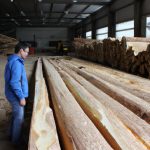

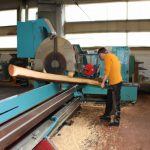


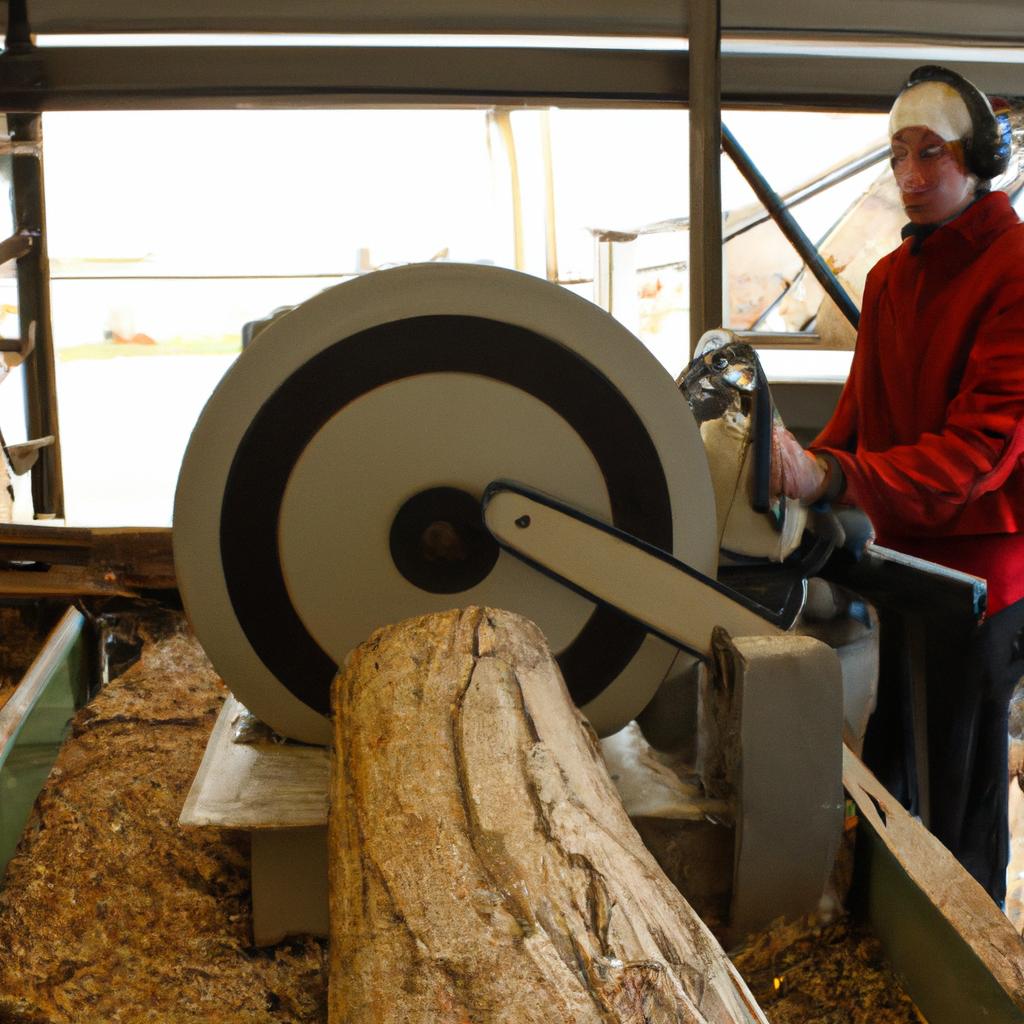
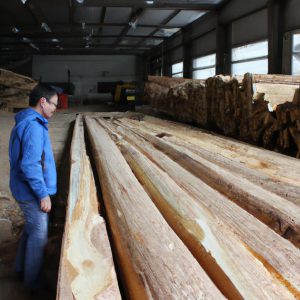
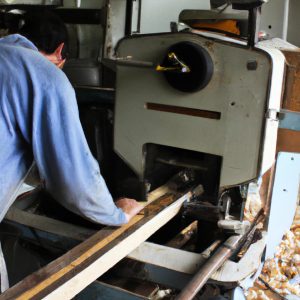
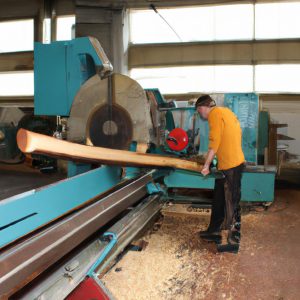
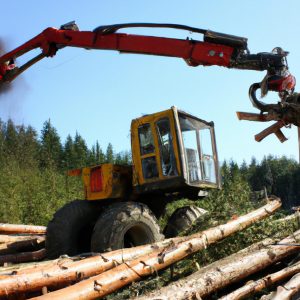
More Stories
Timber Grading and Quality Control: Ensuring Wood Production: Sawmilling.
Sawing Techniques and Technologies in Wood Production: Insights for Sawmilling
Waste Utilization & By-Product Management in Wood Production: Sawmilling